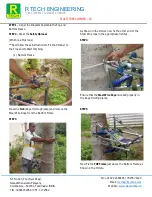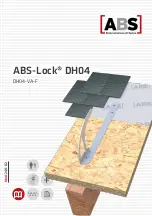
Page 16
Form # B15-790
®
®
®
for suspected leaks. Wear protective gloves and safety glasses or goggles when working with hydraulic
systems. DO NOT DELAY! If an accident occurs, see a doctor familiar with this type of injury immediately.
Any fluid injected into the skin or eyes must be treated within a few hours or gangrene may result.
Always secure equipment with solid supports before working on or under it. Never work under
equipment supported by hydraulics. Hydraulics can drop equipment if controls are actuated or hydraulic lines
burst or pressure is lost while disconnecting lines. Either situation can drop machinery instantly even when
power to hydraulics is off. Do not attempt to disconnect a hydraulic cylinder or hose while the system is
under pressure! Check hydraulic hoses and fittings frequently. Brush and other debris can damage hoses and
fittings. Inspect and maintain equipment daily. Loose, broken, and missing hardware can cause equipment
to not perform properly and can result in bodily injury or death.
Hydraulic systems and oil can be hot and cause burns. Before working on any system, wait until the
oil has cooled.
Lockout / Tagout
Think, plan and check. Think through the entire procedure and identify all the steps that are required.
Plan what personnel will be involved, what needs to be shut down, what guards need to be removed, and how
(and under what conditions) the power will be restarted. Check the machine over to verify all power sources
and stored energy have been identified including engines, hydraulic and pneumatic systems, springs and
accumulators, and suspended loads, Shutoff and lockout power before adjusting, servicing, maintaining, or
clearing an obstruction from this machine. Failure to heed may result in serious injury or death. Communicate
with everyone involved in a repair or maintenance operation, including bystanders, that work is being done
which involves keeping this machine safety at a ZERO ENERGY STATE.
OSHA’s requirements for lockout/tagout are covered in Section 1910.147 of the OSHA standards.
The LOTO standard establishes the employer’s responsibility to protect workers from hazardous energy.
Employers are required to train each worker to ensure that they know, understand, and are able to follow the
applicable provisions of the hazardous energy control procedures:
•
Proper lockout/tagout (LOTO) practices and procedures safeguard workers from the release of
hazardous energy. The OSHA standard for The Control of Hazardous Energy (Lockout/Tagout)
for general industry, outlines specific action and procedures for addressing and controlling
hazardous energy during servicing and maintenance of machines and equipment. Employers
are also required to train each worker to ensure that they know, understand, and
are able to follow the applicable provisions of the hazardous energy control procedures.
Workers must be trained in the purpose and function of the energy control program and have
the knowledge and skills required for the safe application, usage and removal of the energy
control devices.
•
Summary of Contents for Lilliston Rolling Cultivator Generation 3
Page 9: ...Page 9 Form B15 790 FRONT REAR...
Page 49: ...Page 49 Form B15 790 Notes...
Page 50: ...Page 50 Form B15 790 Notes...
Page 51: ...Page 51 Form B15 790 Notes...
Page 52: ......
















































